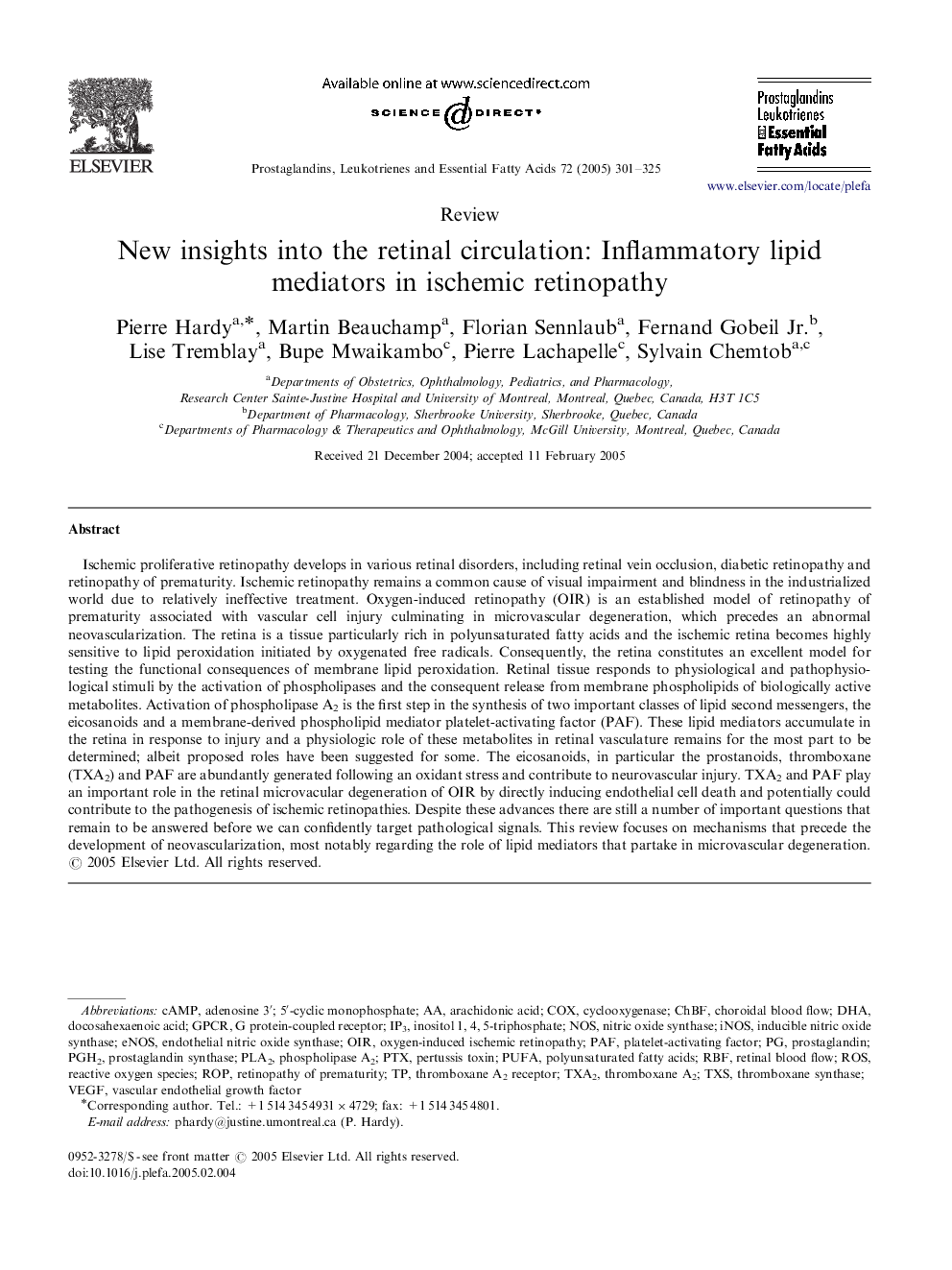| کد مقاله | کد نشریه | سال انتشار | مقاله انگلیسی | نسخه تمام متن |
|---|---|---|---|---|
| 9103786 | 1152841 | 2005 | 25 صفحه PDF | دانلود رایگان |
عنوان انگلیسی مقاله ISI
New insights into the retinal circulation: Inflammatory lipid mediators in ischemic retinopathy
دانلود مقاله + سفارش ترجمه
دانلود مقاله ISI انگلیسی
رایگان برای ایرانیان
کلمات کلیدی
TxA2eNOSIP3iNOSGPCRNOSPTXROPPLA2OIRTXSRBFinositol 1PGH2COX5′-cyclic monophosphate5-triphosphate - 5-تری فسفاتcAMP - cAMPROS - ROScyclooxygenase - آنزیم سیکلواکسیژنازphospholipase A2 - آنزیم فسفولیپاز A2 Arachidonic acid - اسید آراشیدونیکdocosahexaenoic acid - اسید داکوزاگزوائونیکPolyunsaturated fatty acids - اسید چرب اشباع نشدهPUFA - اسید چرب چند غیراشباعThromboxane A2 - ترومبوکسیان A2thromboxane synthase - ترومبوکسین سنتازretinal blood flow - جریان خون شبکیهChoroidal blood flow - جریان خون کوروئیدDHA - دوکوساهگزائنوئیک اسیدRetinopathy of prematurity - رتینوپاتی پیش از ازدواجpertussis toxin - سموم سورافنیinducible nitric oxide synthase - سنتاز اکسید نیتریک القاییendothelial nitric oxide synthase - سنتاز اکسید نیتریک اندوتلیالVascular endothelial growth factor - فاکتور رشد اندوتلیال عروقیVascular Endothelial Growth Factor (VEGF) - فاکتور رشد اندوتلیال عروقی (VEGF)Platelet-activating factor - فاکتور فعال کننده پلاکتnitric oxide synthase - نیتریک اکسید سنتازPAF - نیروی هوایی پاکستانprostaglandin synthase - پروستاگلاندین سنتازprostaglandin - پروستاگلاندینهاReactive oxygen species - گونههای فعال اکسیژنthromboxane A2 receptor - گیرنده تری گلیسیرین A2G protein-coupled receptor - گیرندههای جفتشونده با پروتئین جی
موضوعات مرتبط
علوم زیستی و بیوفناوری
بیوشیمی، ژنتیک و زیست شناسی مولکولی
بیوشیمی بالینی
پیش نمایش صفحه اول مقاله

چکیده انگلیسی
Ischemic proliferative retinopathy develops in various retinal disorders, including retinal vein occlusion, diabetic retinopathy and retinopathy of prematurity. Ischemic retinopathy remains a common cause of visual impairment and blindness in the industrialized world due to relatively ineffective treatment. Oxygen-induced retinopathy (OIR) is an established model of retinopathy of prematurity associated with vascular cell injury culminating in microvascular degeneration, which precedes an abnormal neovascularization. The retina is a tissue particularly rich in polyunsaturated fatty acids and the ischemic retina becomes highly sensitive to lipid peroxidation initiated by oxygenated free radicals. Consequently, the retina constitutes an excellent model for testing the functional consequences of membrane lipid peroxidation. Retinal tissue responds to physiological and pathophysiological stimuli by the activation of phospholipases and the consequent release from membrane phospholipids of biologically active metabolites. Activation of phospholipase A2 is the first step in the synthesis of two important classes of lipid second messengers, the eicosanoids and a membrane-derived phospholipid mediator platelet-activating factor (PAF). These lipid mediators accumulate in the retina in response to injury and a physiologic role of these metabolites in retinal vasculature remains for the most part to be determined; albeit proposed roles have been suggested for some. The eicosanoids, in particular the prostanoids, thromboxane (TXA2) and PAF are abundantly generated following an oxidant stress and contribute to neurovascular injury. TXA2 and PAF play an important role in the retinal microvacular degeneration of OIR by directly inducing endothelial cell death and potentially could contribute to the pathogenesis of ischemic retinopathies. Despite these advances there are still a number of important questions that remain to be answered before we can confidently target pathological signals. This review focuses on mechanisms that precede the development of neovascularization, most notably regarding the role of lipid mediators that partake in microvascular degeneration.
ناشر
Database: Elsevier - ScienceDirect (ساینس دایرکت)
Journal: Prostaglandins, Leukotrienes and Essential Fatty Acids - Volume 72, Issue 5, May 2005, Pages 301-325
Journal: Prostaglandins, Leukotrienes and Essential Fatty Acids - Volume 72, Issue 5, May 2005, Pages 301-325
نویسندگان
Pierre Hardy, Martin Beauchamp, Florian Sennlaub, Fernand Jr., Lise Tremblay, Bupe Mwaikambo, Pierre Lachapelle, Sylvain Chemtob,